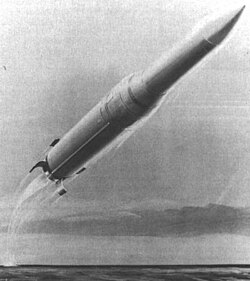This article needs additional citations for verification .(February 2010) |
| UUM-125 Sea Lance | |
|---|---|
 Artist concept | |
| Type | Standoff Anti-Submarine |
| Place of origin | United States |
| Service history | |
| Used by | United States Navy |
| Production history | |
| Manufacturer | Boeing |
| Produced | Cancelled, 1990 |
| Specifications | |
| Mass | 1,400 kg (3,086 pounds) |
| Length | 6.25 m (20 ft 6 in) |
| Diameter | 53.3 cm (21.0 in) (capsule diameter) |
Detonation mechanism | RUM/UUM-125A W89 thermonuclear RUM/UUM-125B Mark 50 homing torpedo |
| Engine | Hercules EX 116 MOD 0 solid-fuel rocket |
Operational range | UUM-125A 185 kilometres (100 nautical miles) UUM-125B 65 kilometres (35 nautical miles) |
| Maximum speed | Mach 1.5 |
Guidance system | Mk 117 digital fire-control system |
Launch platform | Submarines • Los Angeles class • Seawolf class Surface Warships • Ticonderoga class • Spruance class • Arleigh Burke class |

The UUM-125 Sea Lance, known early in development as the Common ASW Standoff Weapon, was to be an American standoff anti-submarine missile, initially intended to carry a W89 thermonuclear warhead. It was conceived in 1980 as a successor to both the UUM-44 SUBROC and RUR-5 ASROC anti-submarine missiles. The Sea Lance was to be available in two versions, known as UUM-125A and RUM-125A. The former would be a submarine-launched version, the latter surface-launched. It was cancelled in 1990 as its importance was obviated by the collapse of the Soviet Union.
